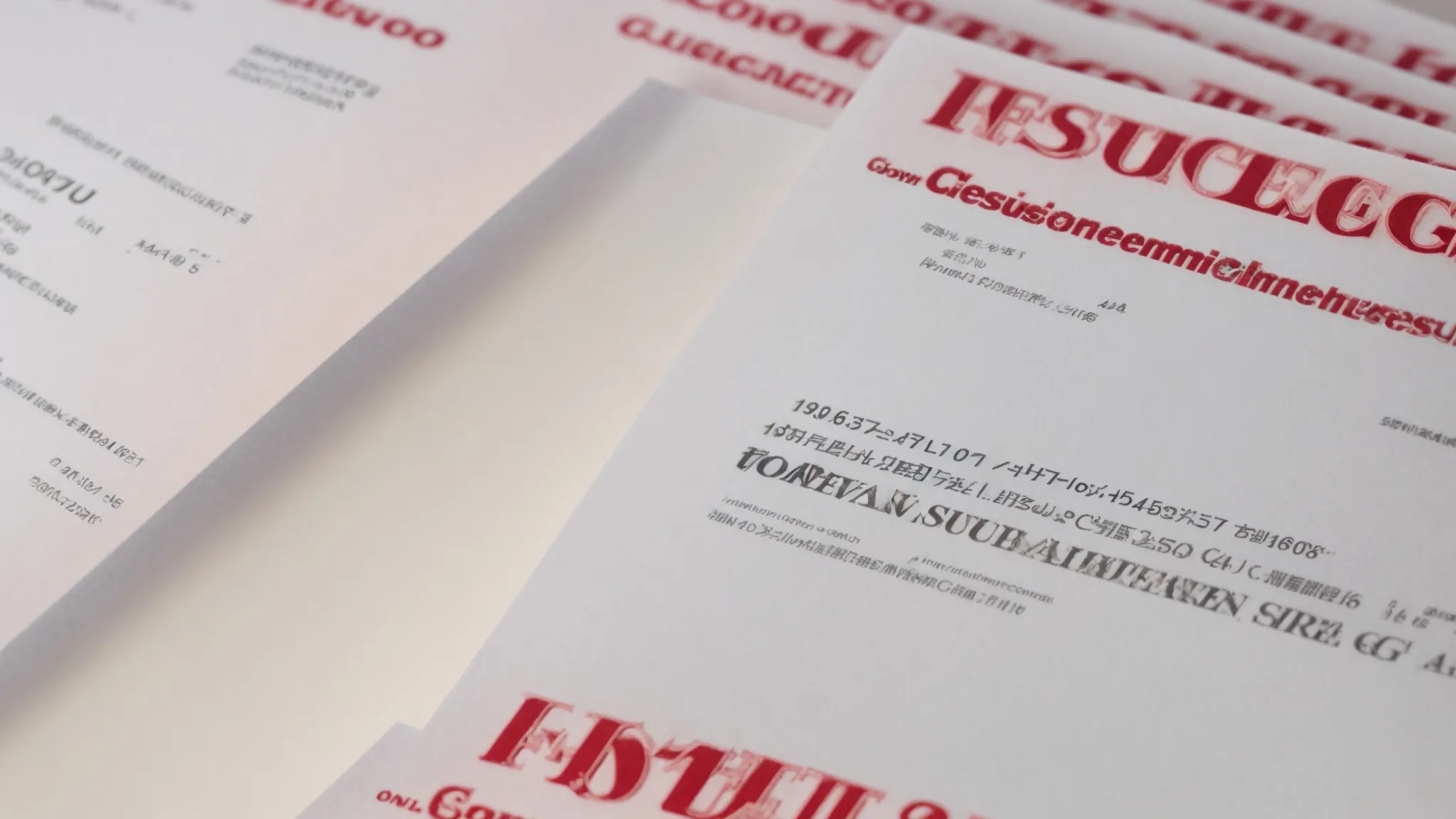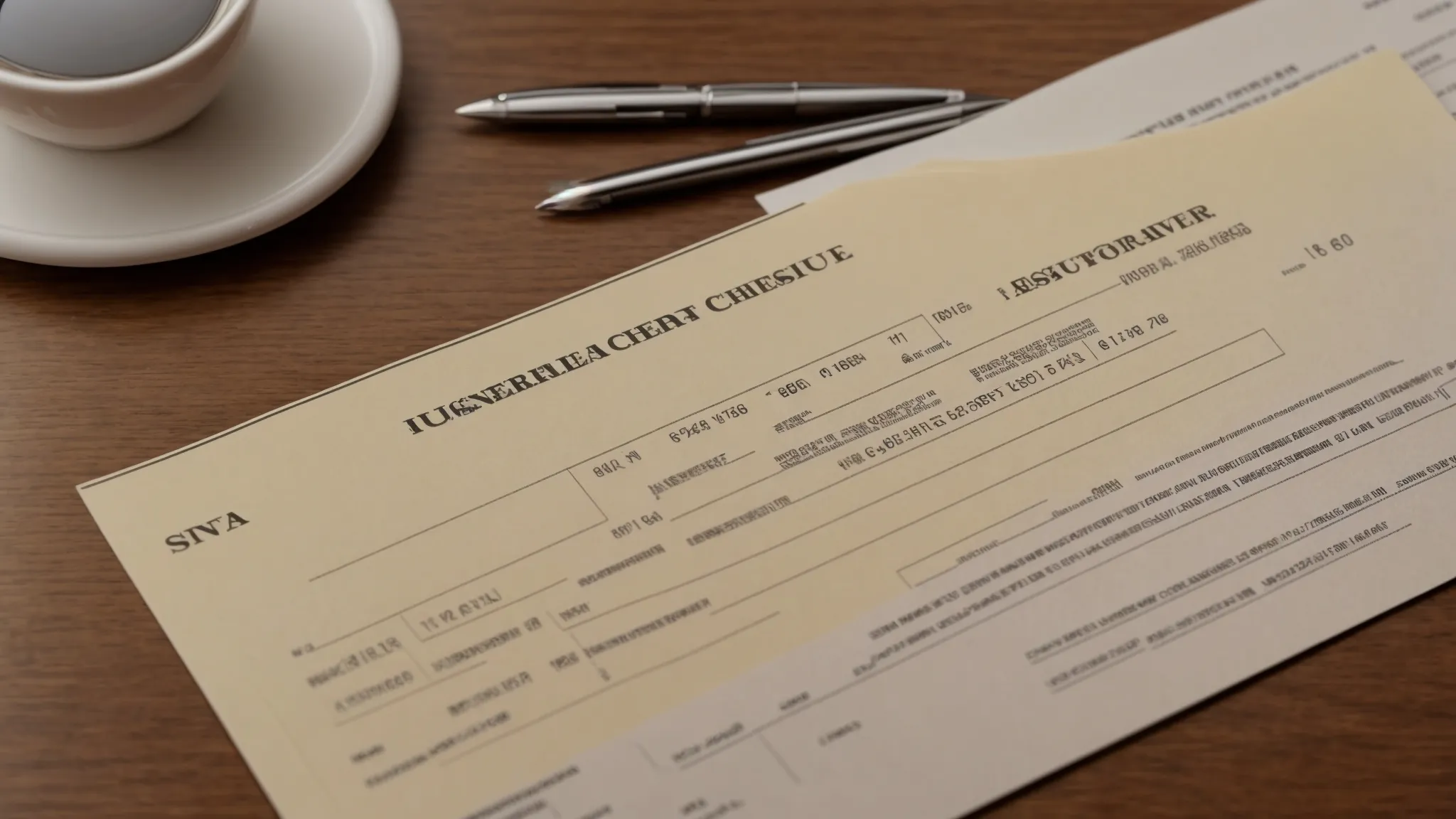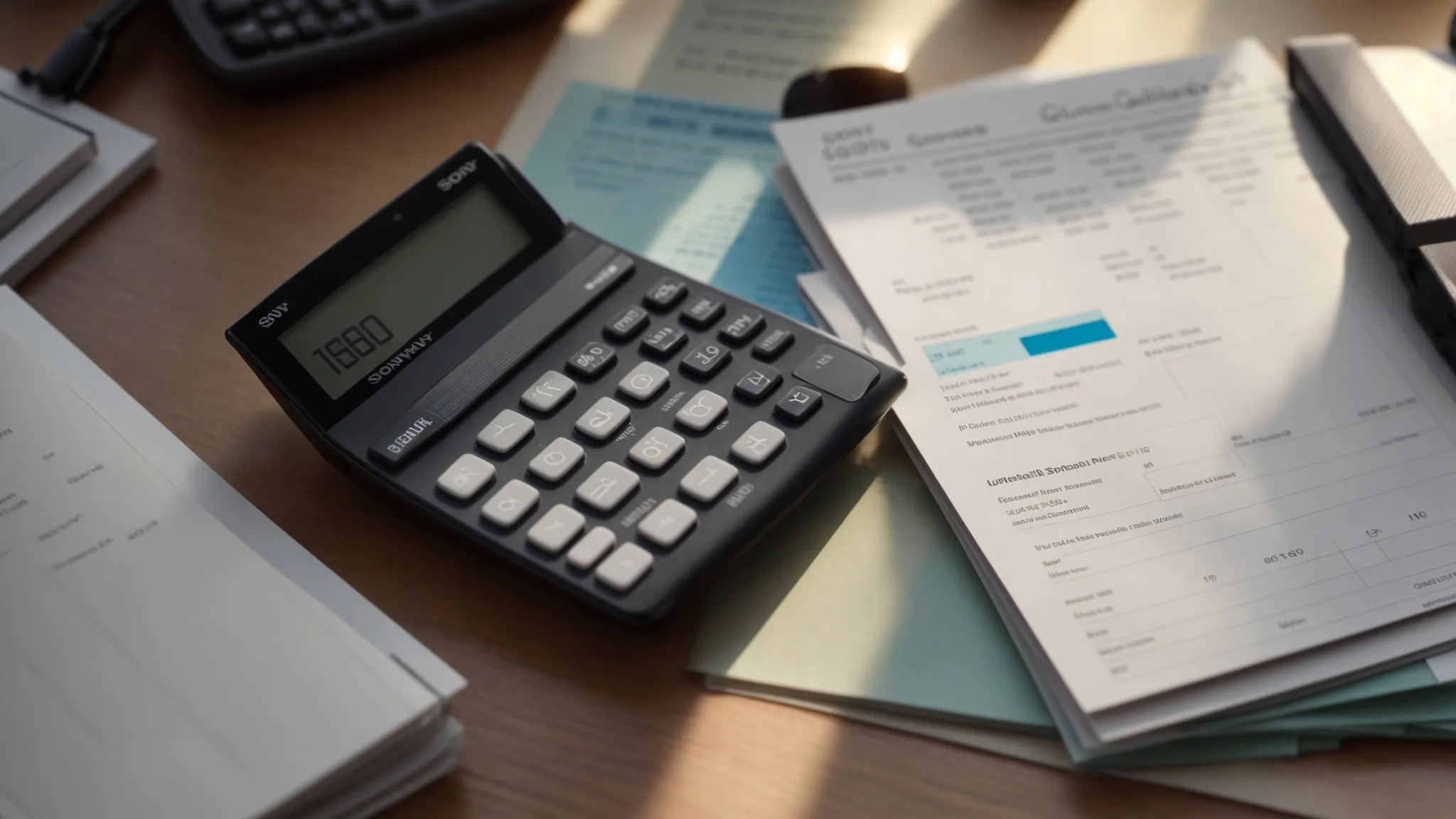**Insufficient Funds on Cheque: What to Do Next** Have you ever had a cheque bounce due to insufficient funds? This situation can cause significant stress and confusion, especially for small business owners. In this article, we will explore the immediate actions you should take when faced with a bounced cheque, steps to resolve the issue effectively, and the potential legal ramifications involved. By reading this, you will learn how to manage this financial failure, ensuring greater sustainability for your business and reducing the impact on your cash flow. Understanding these steps is crucial for maintaining smooth operations while providing the necessary goods and services to your clients.
Understand the Impact of Insufficient Funds on Cheques

Insufficient funds on a cheque can lead to several consequences for the payee, including potential legal action or court appearances. Financial institutions often impose fees and charges, adding to the liability. Additionally, it may impact personal finances, as unpaid obligations can affect credit ratings. Understanding these factors is essential for managing any risks associated with automated clearing house transactions and programs like the Atal Pension Yojana.
Identify the Consequences for the Payee
The consequences of insufficient funds on a cheque can be severe for the payee. If a cheque bounces due to a lack of funds, the payee may face considerable financial penalties, including fines imposed by banks for returned cheques. Additionally, repeated instances of issuing cheques without sufficient funds may lead to potential legal action under the penal code, where the payee could even face imprisonment depending on the circumstances and the intention behind the actions. This creates significant stress for individuals, disrupting their personal finance and potentially resulting in higher interest rates on future loans due to damaged creditworthiness.
In more practical terms, a payee may not only find themselves in a precarious legal position but might also encounter challenges in their everyday transactions. For instance, businesses rely on timely payments. When a cheque is returned due to insufficient funds, it can strain relationships between vendors and clients, leading to delayed services or additional charges. Understanding these consequences underscores the importance of maintaining adequate funds and highlights the need for individuals and businesses to have a robust financial management strategy to safeguard their interests.
Recognize Potential Fees and Charges
When a cheque is returned due to insufficient funds, the drawer often faces immediate fees imposed by their financial institution. Banks typically charge a returned cheque fee which can range significantly, sometimes affecting the salary or wages of the individual if they are already experiencing financial strain. This situation can lead to a cycle of debt, where repeated insufficient funds may further disrupt their financial equity, complicating the management of everyday expenses.
Moreover, the ongoing repercussions of bounced cheques may extend beyond bank charges. If insufficient funds continue to occur, the drawer risks potential legal actions, including hefty fines or even prison time in severe cases, especially where intent to defraud is suspected. Such scenarios can also disrupt essential financial responsibilities, like securing life insurance policies, as insurers often evaluate an individual’s financial reliability based on their banking history, including cheque transactions.
Evaluate Personal Financial Implications
Insufficient funds on a cheque can create significant personal financial implications for the drawer. When a cheque bounces, it often leads to bank fees and potential charges from creditors, exacerbating an already delicate financial situation. Individuals may find themselves unable to meet basic obligations, resulting in late payments that can negatively impact credit scores and affect future borrowing capabilities.
Moreover, the stress associated with insufficient funds can tempt individuals to engage in risky financial behaviors. For instance, reliance on mobile banking apps for managing funds might not address the underlying issues that led to insufficient balances. Without a solid financial plan, the risk of being labeled as a repeat offender can arise, making it easier for institutions to view them suspiciously and potentially involving a legal aspect that might even hint at crimes related to cheque fraud. Understanding these implications emphasizes the necessity for maintaining a sufficient bond between income and expenditures to safeguard personal financial health.
Assess the Impact on Credit Ratings
Insufficient funds on a cheque can severely impact an individual’s credit rating, as financial institutions report defaults and bounced cheques to credit bureaus. A lowered credit score can hinder access to vital financial services, such as loans for purchasing a vehicle or obtaining a mortgage. Additionally, individuals may struggle with approvals for the national pension system or other essential programs that require a reliable credit history.
Furthermore, frequent instances of insufficient funds can lead to increased scrutiny by lenders and creditors. This scrutiny may result in higher interest rates on future loans or denied applications due to perceived financial instability. To mitigate damage to their credit, individuals are encouraged to utilize tools like the unified payments interface for better transaction management, ensuring adequate funds are always available when writing cheques.
Insufficient funds create serious problems. Knowing what to do when a cheque bounces can help you regain control and move forward.
Immediate Actions to Take When a Cheque Bounces

Upon discovering that a cheque has bounced due to insufficient funds, it is vital for individuals to take immediate action. The first step is to contact the bank for clarification regarding the transaction and related fees. Next, prompt communication with the payee is essential to maintain trust, especially if the bounced cheque pertains to an invoice. Additionally, reviewing the account balance and recent transactions in the online banking system can help identify discrepancies and prevent future occurrences. Understanding these steps is critical to managing the impacts on one’s savings account and ensuring compliance with the Indian penal code regarding financial duties.
Contact the Bank for Clarification
Upon realizing that a cheque has bounced, it is essential for individuals to promptly contact their bank for clarification. This conversation will help clarify the reasons behind insufficient funds, allowing the account holder to understand the specific circumstances that led to the returned cheque. Understanding these details is crucial as it can influence one’s decisions regarding mortgage payments or upcoming wire transfers, ensuring that future transactions occur smoothly.
During the call, individuals should inquire about any associated fees or implications related to the bounced cheque, particularly if it relates to significant assets or ongoing financial obligations. Additionally, it’s wise to ask the bank if they have detected any potential fraud, as this understanding can play a vital role in safeguarding financial health. Taking these proactive steps can help mitigate further issues and establish a solid foundation for better financial practices moving forward.
Communicate With the Payee Promptly
Prompt communication with the payee after a cheque bounces is essential to maintain good relationships and prevent further complications. The situation can be sensitive, particularly if the amount involved is significant, as delays in addressing the issue may lead to a lawsuit or other legal actions. Being transparent about the circumstances enabling the occurrence of insufficient funds can help ease tensions and demonstrate a willingness to resolve the matter amicably.
In conversations with the payee, it is important to discuss repayment options or alternative arrangements to cover the expense. Cultivating a proactive approach may discourage them from seeking a lawyer, which could escalate the situation to a trial or involve a magistrate‘s intervention. Open dialogue can pave the way for a constructive solution, reducing the risk of detrimental legal consequences and preserving a positive working relationship.
Review Your Account Balance and Transactions
After a cheque bounces due to insufficient funds, it is crucial to review the account balance and recent transactions thoroughly. This examination helps identify any discrepancies that may have contributed to the unexpected lack of funds, such as unanticipated fees or pending transactions related to services like FASTag. Understanding the flow of money can provide helpful insights for future financial management and ensure that higher interest rates on loans or business loans are avoided due to sudden overdrafts.
By analyzing the account details, individuals can pinpoint areas where financial adjustments are needed. For instance, fintech applications can be utilized to track expenses efficiently, enabling better planning for upcoming obligations. A clear view of the financial situation not only assists in resolving immediate challenges but also supports a more robust financial strategy moving forward, minimizing risks associated with bounced cheques.
A bounced cheque is just the start of the trouble. To find a way out, one must confront the issue of insufficient funds head-on.
Steps to Resolve Insufficient Funds Issues

To address issues arising from insufficient funds on a cheque, it is essential to take immediate and effective actions. Individuals should first deposit sufficient funds to cover the cheque amount, ensuring compliance with the regulations set forth by the Reserve Bank of India regarding negotiable instruments. Exploring alternatives for payment can alleviate potential disruptions, while establishing overdraft protection offers added security against future occurrences. These steps provide practical solutions that can safeguard financial interests and maintain positive remittance relationships.
Deposit Sufficient Funds to Cover the Cheque
To effectively resolve issues related to insufficient funds on a cheque, the first step is to deposit sufficient funds into the account to cover the outstanding amount. Individuals should prioritize saving to ensure there is enough balance available for any future cheque transactions. Utilizing a line of credit can be a temporary solution; however, it is essential to consistently monitor spending habits to avoid potential overuse, which might lead to additional financial strain.
In addition to managing immediate cash flow, individuals may consider other financial strategies, such as establishing a fixed deposit for emergency funds. By doing so, they create a safety net that can be accessed when unexpected expenses arise, including situations where a cheque may bounce. Furthermore, exploring options like a demat account could help manage investments more effectively, providing both growth potential and liquid assets that can be drawn upon in critical moments, ensuring stability in their financial dealings.
Consider Alternatives for Payment
One effective way to handle situations arising from insufficient funds on a cheque is to consider alternative payment methods. Options like electronic fund transfers through a clearing house can provide a quicker and more reliable means of settling debts. This approach mitigates the risk of returned cheques and helps maintain good relationships with vendors, which is especially vital for businesses relying on consistent cash flow.
Moreover, individuals can explore payment options that allow for greater flexibility. Utilizing services associated with government schemes, such as the Pradhan Mantri Suraksha Bima Yojana, can offer additional financial security. It’s also wise to keep an overdraft facility available for emergencies, enabling one to cover unexpected expenses without recurring financial strain. Adopting these strategies can significantly enhance financial management and prevent complications linked to insufficient funds.
Set Up Overdraft Protection
Setting up overdraft protection can serve as a vital safety net for individuals managing their finances. This option allows account holders to access additional funds when their account balance is insufficient, helping to prevent bounced cheques that might otherwise incur fees or damage credit scores. By having overdraft protection in place, individuals can avoid potential legal complications, like those involving claims from a prosecutor for unresolved debts, while ensuring they can meet essential payments such as vehicle insurance or mutual fund contributions.
Moreover, implementing overdraft protection can foster better financial stability by providing a cushion during unexpected expenses or fluctuations in income. This strategy enables individuals to focus on maintaining a healthy financial plan without the stress of insufficient funds disrupting their operations. Ultimately, securing overdraft protection enhances peace of mind, allowing individuals to manage their obligations effectively while safeguarding their financial reputation.
Handling insufficient funds can feel overwhelming, but the stakes rise when dealing with legal consequences. Understanding these ramifications can help protect your business and keep your operations running smoothly.
Legal Ramifications of Insufficient Funds on Cheques

Understanding the legal ramifications associated with insufficient funds on a cheque is crucial for individuals and businesses alike. This section covers essential aspects such as the laws related to dishonoured cheques, potential criminal charges that issuers may face, and considerations for filing a complaint if necessary. Each topic sheds light on the implications these situations can have on one’s financial standing, including matters related to business loans and programs like the Pradhan Mantri Jeevan Jyoti Bima Yojana.
Understand Laws Related to Bad Cheques
Understanding the laws related to bad cheques is essential for both individuals and businesses. In many jurisdictions, issuing a cheque without sufficient funds can lead to significant legal repercussions. Punishment for such actions may include fines or, in serious cases, imprisonment, especially if there is a suspicion of intent to defraud. Maintaining a good credit score becomes increasingly difficult when legal issues arise from bounced cheques, which can affect an individual’s or business’s financial stability and ability to secure a letter of credit.
Moreover, individuals might seek remedies for bounced cheques through the legal system, necessitating knowledge of relevant laws governing such disputes. Recognizing these legal frameworks also emphasizes the importance of maintaining adequate funds, such as through a recurring deposit, to avoid the complications associated with insufficient funds. Addressing these legal concerns proactively can help mitigate risks and protect financial interests while ensuring compliance with existing laws.
Evaluate Potential Criminal Charges
Issuing a cheque without sufficient funds can lead to potential criminal charges, including serious consequences such as fines or even imprisonment. In many jurisdictions, if an individual is suspected of attempting to defraud others by writing bad cheques, they may receive a summons to appear in court. Such legal complications can severely impact financial stability, including damaging a person’s relationship with credit bureaus and affecting their ability to secure loans, including EMIs for significant purchases or investments.
The implications of bouncing cheques extend beyond immediate penalties; the individual risks facing cumulative liabilities that can accumulate over time, especially if the amount is substantial, like in lakhs. Consistently lacking adequate cash to cover issued cheques not only raises legal concerns but also contributes to a negative financial record, which can haunt one’s credit profile. Understanding these potential charges underscores the importance of maintaining sufficient funds to avoid these dire consequences in business and personal financial dealings.
Consider Filing a Complaint if Necessary
In circumstances where a cheque bounces due to insufficient funds, the payee may consider filing a complaint if attempts to rectify the situation have failed. This action can provide a formal record of the incident, which may be necessary for legal proceedings or future disputes. Understanding the relevant laws governing dishonoured cheques can guide individuals in determining whether a complaint is warranted, ensuring they protect their rights in these financial dealings.
Filing a complaint can be a crucial step if the drawer shows a pattern of issuing bad cheques without resolution. Individuals may approach the appropriate legal authorities or financial institutions to initiate this process, seeking to reclaim lost amounts or address repeated offenses. By taking this action, the payee not only stands to resolve their immediate issue but also reinforces the importance of accountability in financial transactions.
Understanding the legal dangers of insufficient funds is just the first step. Now, let’s look at practical ways to avoid these issues and safeguard your business’s finances.
Preventing Future Insufficient Funds Issues

To prevent future issues with insufficient funds on cheques, individuals should focus on maintaining a regular budget and tracking financial activity diligently. Establishing an emergency savings fund can provide security against unexpected costs, while frequent monitoring of account activity helps catch discrepancies early. These strategies form a solid foundation for better financial management, ensuring funds are available when needed.
Maintain a Regular Budget and Financial Tracking
Maintaining a regular budget is essential for managing finances effectively and avoiding insufficient funds on cheques. By tracking income and expenses meticulously, individuals can gain a clear understanding of their financial situation. This practice allows for better planning, ensuring that enough funds are available when obligations arise, thus minimizing the risk of issuing cheques that could bounce.
Financial tracking can be further enhanced by utilizing budgeting tools and apps, which provide real-time updates on spending habits. Regular reviews of account statements help individuals spot discrepancies or unexpected charges early, allowing for timely adjustments. By cultivating these habits, individuals not only safeguard their financial stability but also build a foundation for healthier financial practices, reducing the potential for future cheque-related issues.
Establish Emergency Savings for Unexpected Expenses
Establishing an emergency savings fund is a critical step in preventing insufficient funds on cheques. By setting aside a specific amount of money each month, individuals can create a financial buffer that protects against unexpected expenses, such as medical emergencies or urgent home repairs. This proactive approach ensures that there are available funds when it’s time to write a cheque, thereby reducing the risk of bounced payments and associated penalties.
For effective emergency savings, it is essential to determine a target amount that sufficiently covers potential sudden costs. Financial experts often recommend saving at least three to six months’ worth of living expenses to provide a solid safety net. Having this reserve not only enhances financial stability but also promotes peace of mind, allowing individuals to manage their finances with confidence and assurance that they are prepared for unforeseen situations.
Monitor Account Activity Frequently
Monitoring account activity frequently is a crucial step in preventing insufficient funds issues for individuals and businesses alike. By regularly checking bank statements and transaction histories, account holders can quickly identify discrepancies or unexpected charges that may lead to an inadequate balance. This proactive approach ensures that there is always sufficient funding available when writing cheques, ultimately avoiding the stress that comes from bounced payments.
Additionally, utilizing banking apps and online tools can simplify the monitoring process for users. Many financial institutions offer real-time notifications for account activities, allowing individuals to stay informed about their finances easily. By implementing these monitoring practices, account holders can maintain better control over their financial situations, contributing to overall financial health and reducing the risk of cheque-related complications.
When problems arise with insufficient funds, questions often follow. In the next section, common inquiries about cheque-related issues will be addressed, shedding light on solutions and concerns.
Frequently Asked Questions About Insufficient Funds on Cheques

When facing insufficient funds on a cheque, understanding the implications is crucial. Topics covered include what happens if a cheque is returned, how many times a cheque can bounce, the fees associated with insufficient funds, and strategies to prevent future occurrences. This information provides practical insights to help individuals navigate the challenges of managing their finances while maintaining healthy financial practices.
What Happens if a Cheque Is Returned?
When a cheque is returned due to insufficient funds, the payee typically receives a notice from their bank indicating that the cheque could not be processed. This situation often leads to additional bank fees for both the drawer and the payee, which can create unnecessary financial strain. For businesses relying on timely payments, this disruption can result in delayed services or strained vendor relationships, making it essential for individuals to ensure that sufficient funds are maintained in their accounts.
Furthermore, a returned cheque may lead to complications regarding future transactions and creditworthiness. Many banks will report returned cheques to credit bureaus, which can harm an individual’s credit score. As a result, the affected individuals may face challenges in securing loans or credit in the future. To avoid such consequences, maintaining a careful watch over finances and communicating promptly with relevant parties can help mitigate potential issues associated with insufficient funds on cheques.
How Many Times Can a Cheque Bounce?
The number of times a cheque can bounce due to insufficient funds largely depends on the policies of the financial institutions involved. Generally, a cheque can bounce several times if the drawer does not deposit sufficient funds to cover the amount owed. Each bounce incurs bank fees, which can escalate quickly, negatively impacting the drawer‘s financial standing and potentially leading to legal ramifications if continued patterns emerge.
It is crucial for individuals to understand that consistently bouncing cheques may result in being flagged by banks, affecting their ability to write cheques in the future. Affected individuals should take proactive steps to manage their finances and ensure sufficient funds are maintained in their accounts. By doing so, they can avoid the complications of repeated bounced cheques and maintain better relationships with vendors and financial institutions.
What Are the Fees Associated With Insufficient Funds?
When a cheque bounces due to insufficient funds, the drawer typically incurs a returned cheque fee imposed by their bank. This fee can vary significantly between institutions and often ranges from $25 to $45, adding unexpected costs to an already challenging situation. Such fees not only create financial strain but also emphasize the importance of maintaining sufficient funds in an account to avoid these consequences.
Additionally, businesses that receive a bounced cheque may attempt to recover costs by charging their own fees for handling the returned payment. This can further escalate the financial burden on the drawer, especially if multiple bounced cheques occur. Recognizing these charges highlights the need for individuals and businesses to implement sound financial practices, ensuring that funds are consistently available to meet obligations and avoid costly penalties.
How Can I Avoid Insufficient Funds in the Future?
To prevent insufficient funds on cheques in the future, individuals should prioritize maintaining a budget that accounts for all income and expenses. By regularly tracking these financial activities, they can ensure that they always have adequate funds available before issuing cheques. Utilizing technology, such as personal finance apps, can help streamline this process, alerting users to low balances and upcoming payments.
In addition, establishing an emergency savings fund can significantly reduce the risk of insufficient funds. This safety net can be accessed during unexpected financial challenges, offering a buffer that ensures cheques clear without complications. By combining proactive budgeting with savings, individuals can enhance their overall financial stability and avoid the consequences associated with insufficient funds on cheques.

